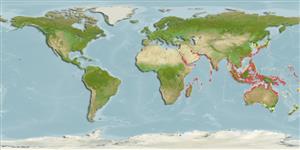Teleostei (teleosts) >
Carangiformes (Jacks) >
Carangidae (Jacks and pompanos) > Caranginae
Etymology: Alepes: Greek, alepis, -idos = without scales (Ref. 45335).
More on author: Cuvier.
Environment: milieu / climate zone / depth range / distribution range
Ecology
Marine; brackish; pelagic-neritic; depth range 0 - 10 m (Ref. 86942). Tropical
Indo-West Pacific: tropical waters.
Size / Weight / Age
Maturity: Lm ? range ? - ? cm
Max length : 61.0 cm TL male/unsexed; (Ref. 117080); common length : 30.0 cm FL male/unsexed; (Ref. 3287)
Adults are common in shallow coastal waters where it often swims near the surface. They form dense schools on clear inner reefs, swimming high above substrate (Ref. 48635). They feed chiefly on shrimps, copepods, decapods and small fishes (Ref. 30573, 90102).
Life cycle and mating behavior
Maturity | Reproduction | Spawning | Eggs | Fecundity | Larvae
Paxton, J.R., D.F. Hoese, G.R. Allen and J.E. Hanley, 1989. Pisces. Petromyzontidae to Carangidae. Zoological Catalogue of Australia, Vol. 7. Australian Government Publishing Service, Canberra, 665 p. (Ref. 7300)
IUCN Red List Status (Ref. 130435: Version 2024-1)
Threat to humans
Harmless
Human uses
Fisheries: minor commercial
Tools
Special reports
Download XML
Internet sources
Estimates based on models
Preferred temperature (Ref.
123201): 23.8 - 29.2, mean 28.5 °C (based on 2765 cells).
Phylogenetic diversity index (Ref.
82804): PD
50 = 0.5312 [Uniqueness, from 0.5 = low to 2.0 = high].
Bayesian length-weight: a=0.01148 (0.00721 - 0.01828), b=2.90 (2.77 - 3.03), in cm total length, based on LWR estimates for this species & (Sub)family-body (Ref.
93245).
Trophic level (Ref.
69278): 3.7 ±0.55 se; based on food items.
Resilience (Ref.
120179): Medium, minimum population doubling time 1.4 - 4.4 years (Preliminary K or Fecundity.).
Fishing Vulnerability (Ref.
59153): Moderate vulnerability (44 of 100).
Nutrients (Ref.
124155): Calcium = 146 [81, 356] mg/100g; Iron = 1.6 [0.9, 3.1] mg/100g; Protein = 19.6 [18.4, 20.9] %; Omega3 = 0.232 [0.126, 0.448] g/100g; Selenium = 29.1 [14.4, 61.8] μg/100g; VitaminA = 16.4 [4.7, 49.0] μg/100g; Zinc = 1.34 [0.94, 1.93] mg/100g (wet weight);
